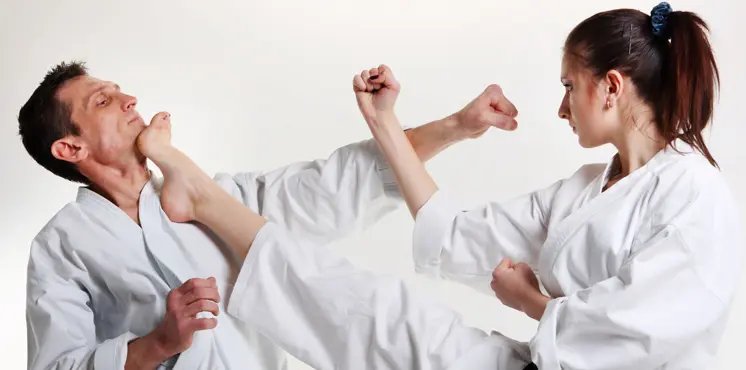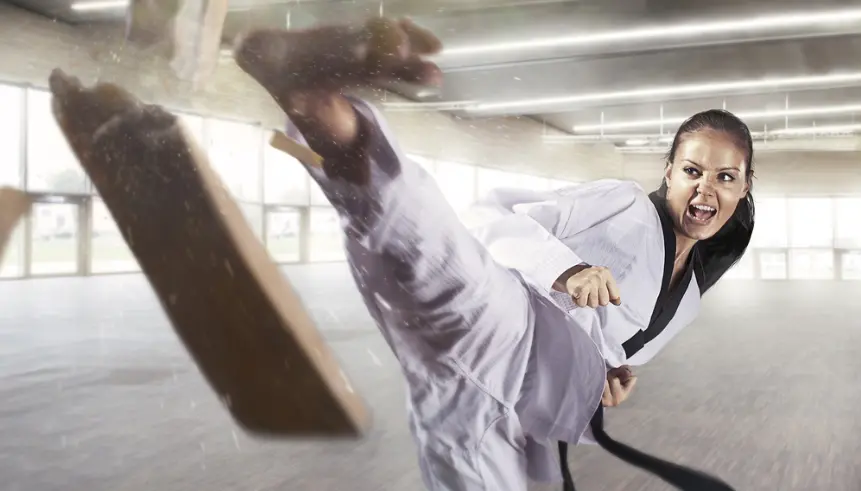The Importance of Kicks in Self-Defense: Kicking is one of the most powerful self-defense techniques you can learn. No matter if you’re just starting out or have years of experience, perfecting your kicking skills can greatly improve your self-protection abilities.
The Importance of Kicks in Self-Defense
 In self-defense, a kick means using your legs to strike an assailant, intending to incapacitate or dissuade them from their attack. Kicks are particularly powerful because the legs can deliver more force than the arms, making it possible to land significant blows even from a distance.
In self-defense, a kick means using your legs to strike an assailant, intending to incapacitate or dissuade them from their attack. Kicks are particularly powerful because the legs can deliver more force than the arms, making it possible to land significant blows even from a distance.
The Power of Kicking
Kicks harness the power of the lower body, using the strong muscles in the legs to deliver impactful strikes. When performed properly, a kick can incapacitate an attacker, creating a vital opportunity to flee or take charge of the situation. This highlights the importance of kicking as a key self-defense technique, especially for individuals who might not have the upper body strength to depend only on punches.
Types of Kicks in Self-Defense
It’s important to comprehend the different kinds of kicks and their uses. Here are a few common kicks that are effective in self-defense:
Front Kick
The front kick is a fundamental and powerful technique in self-defense. It consists of raising your knee and extending your leg to hit your opponent with the ball of your foot. This kick is aimed at the groin, stomach, or knees, delivering considerable pain or even incapacitating them.
Roundhouse Kick
A roundhouse kick is executed with a sweeping motion, where the leg arcs around to hit the opponent using the top of the foot or shin. This technique is quite powerful and can effectively target different areas of the body, such as the ribs, thighs, or head, based on the circumstances and the defender’s range of motion.
Side Kick
The side kick is a powerful defensive technique where you turn your body sideways and extend your leg to hit with your heel. This kick aims for the attacker’s midsection or legs, using your entire body weight and strength to deliver a strong impact.
Back Kick
Known as a mule kick, the back kick involves delivering a backward strike with your heel. This kick is particularly advantageous when an attacker sneaks up from behind, giving you the ability to counter without fully turning around.
Benefits of Learning Kicks for Self-Defense
Increased Reach
A major advantage of utilizing kicks in self-defense is the extended reach they provide. Since legs are generally longer than arms, you can maintain a safe distance from your assailant while still delivering strong strikes.
Enhanced Power
Kicks can produce a lot of power, sometimes even surpassing that of punches. The strength comes from the larger muscle groups in the legs, which makes kicks a highly effective method for quickly neutralizing an attacker.
Versatility
Kicks can be applied in a variety of situations and can hit different parts of the body. This versatility is what makes them an important tool in self-defense, offering several ways to react when faced with an attack.
Practicing Kicks for Self-Defense
Proper Technique
Mastering the right technique is crucial for successful kicking. If kicks are not performed correctly, they can result in injuries or diminish their effectiveness. Concentrating on balance, posture, and proper form is key to ensuring each kick has the greatest impact.
Drills and Training
Consistent practice is essential for perfecting your kicks. Engaging in drills that emphasize speed, precision, and strength can significantly boost your kicking abilities. Training with a partner or utilizing a punching bag can mimic real-life situations, making you more adept at using kicks effectively in self-defense.
Flexibility and Strength
Boosting your flexibility and strength can significantly improve your kicking skills. By incorporating stretching routines and leg strength training, you can expand the range and power of your kicks, making them more effective for self-defense.
Situational Awareness and Kicking
Kicks can be incredibly effective, but knowing when and how to deploy them is crucial. Being aware of your surroundings is essential in self-defense, as it helps you identify possible dangers and respond effectively. Use kicks thoughtfully, taking into account the position of your attacker, the distance between you, and the setting around you.
Legal and Ethical Considerations
Grasping the legal and ethical aspects of using kicks for self-defense is essential. Although self-defense is often warranted, using too much force can result in legal repercussions. It’s vital to apply only the amount of force needed to ensure your safety and to prioritize escaping or calming the situation whenever you can.
Conclusion
Learning how to kick effectively for self-defense can really boost your ability to stay safe. Whether it’s the basic front kick or the more forceful side kick, each kick has its own strengths for different circumstances. By familiarizing yourself with the different types of kicks, their benefits, and the best ways to practice them, you can create a strong foundation in self-defense. Always remember that the main purpose of self-defense is to keep yourself safe, so use your skills wisely and ethically.
For More Self Defense Guides, And Tips Please Visit Our Homepage.

Leave a Reply